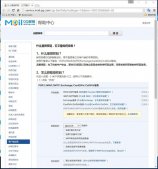Stream流多字段求和、汇聚
实现方法
利用
|
1
|
Collectors.toMap(Function keyMapper, Function valueMapper, BinaryOperator mergeFunction) |
-
keyMapper:代表你最终想要获得的Map<Key, Value> 的Key -
valueMapper:代表你最终想要获得的Map<Key, Value> 的Value -
mergeFunction:表示碰到Key冲突是处理过程,{x, y}中x是已汇聚对象,y表示当前处理对象
对象类型数据处理
|
1
2
3
|
public static Map<String, Model> streamGroupSum(List<Model> datas){ return datas.stream().collect(Collectors.toMap(k -> k.getCode(), v -> v, (x, y) -> x.addCount().addAll(y))); } |
Model
|
1
2
3
4
5
6
7
8
9
10
11
12
13
14
15
16
17
18
19
20
21
22
23
24
25
26
27
28
|
@Dataclass Model{ private String code; private int count = 0; private Integer sum1; private Integer sum2; public Model(String code, Integer sum1, Integer sum2){ this.code = code; this.sum1 = sum1; this.sum2 = sum2; } public Model addCount(){ this.count++; return this; } public Model addAll(Model y){ return add(Model::setSum1, Model::getSum1, y) .add(Model::setSum2, Model::getSum2, y); } /** * 使用函数式编程,最终目的是为了求和,类似反射,具体使用方式请移步函数式编程 */ public Model add(BiConsumer<Model, Integer> set, Function<Model, Integer> get, Model y){ set.accept(this, get.apply(this) + get.apply(y)); return this; } } |
Map类型数据处理
|
1
2
3
4
5
6
7
8
9
10
11
12
13
14
15
16
17
18
19
20
21
22
23
24
25
26
27
28
29
30
31
32
33
34
35
36
37
38
39
40
41
42
43
44
45
46
|
public static void main (String[] args) { List<Map<String, Object>> datas = getDatas(); streamMapSum(datas); } public static Map<Object, Map<String, Object>> streamMapSum (List<Map<String, Object>> datas) { return datas.stream() .collect(Collectors.toMap(k -> k.get("name"), v -> { v.put("count", 1); return v; } , (x, y) -> { x.put("count", (int) x.get("count") + 1); x.put("aaa", (int) x.get("aaa") + (int) y.get("aaa")); x.put("bbb", (int) x.get("bbb") + (int) y.get("bbb")); x.put("ccc", (int) x.get("ccc") + (int) y.get("ccc")); return x; /* //使用ofMap重构 return ofMap("name", x.get("name") , "count", (int) x.get("count") + 1 , "aaa", add(x, y, "aaa") , "bbb", add(x, y, "bbb") , "ccc", add(x, y, "ccc"));*/ } ) ); } public static int add (Map<String, Object> x, Map<String, Object> y, String key) { return (int) x.get(key) + (int) y.get(key); } public static Map<String, Object> ofMap (Object... objs) { System.out.println("ofMap"); Map<String, Object> map = new LinkedHashMap<>(); for (int i = 0; i < objs.length; i = i + 2) { map.put(objs[i].toString(), objs[i + 1]); } return map; } public static List<Map<String, Object>> getDatas () { List<Map<String, Object>> list = new ArrayList<>(); list.add(ofMap("name", "张三", "aaa", 3, "bbb", 5, "ccc", 6)); list.add(ofMap("name", "张三", "aaa", 8, "bbb", 51, "ccc", 521)); list.add(ofMap("name", "李四", "aaa", 9, "bbb", 53, "ccc", 23)); return list; } |
Stream分组求和使用笔记
话不多说,直接贴代码,分组使用
|
1
2
3
4
5
6
7
8
9
10
11
12
13
14
15
16
17
18
19
20
|
class Foo { private int code; private int count; public Foo(int code, int count) { this.code = code; this.count = count; } public int getCode() { return code; } public void setCode(int code) { this.code = code; } public int getCount() { return count; } public void setCount(int count) { this.count = count; }} |
|
1
2
3
4
5
6
7
8
9
10
11
12
13
14
15
|
public static void main(String[] args) { Foo foo1 = new Foo(1, 2); Foo foo2 = new Foo(2, 23); Foo foo3 = new Foo(2, 6); List<Foo> list = new ArrayList<>(4); list.add(foo1); list.add(foo2); list.add(foo3); Map<Integer, List<Foo>> collect = list.stream().collect(Collectors.groupingBy(Foo::getCode)); List<Foo> list1 = collect.get(1); List<Foo> list2 = collect.get(2); list1.forEach(e -> System.out.println(e.getCode() + ":" + e.getCount())); System.out.println("-----------这里是分界线-----------------------------"); list2.forEach(e -> System.out.println(e.getCode() + ":" + e.getCount())); } |
输出结果:
1:2
-----------这里是分界线-----------------------------
2:23
2:6
分组求和使用
|
1
2
3
4
5
6
7
8
9
10
11
12
13
14
15
16
17
18
19
20
21
22
|
public static void main(String[] args) { Foo foo1 = new Foo(1, 2); Foo foo2 = new Foo(2, 23); Foo foo3 = new Foo(2, 6); List<Foo> list = new ArrayList<>(4); list.add(foo1); list.add(foo2); list.add(foo3); Map<Integer, IntSummaryStatistics> collect = list.stream().collect(Collectors.groupingBy(Foo::getCode, Collectors.summarizingInt(Foo::getCount))); IntSummaryStatistics statistics1 = collect.get(1); IntSummaryStatistics statistics2 = collect.get(2); System.out.println(statistics1.getSum()); System.out.println(statistics1.getAverage()); System.out.println(statistics1.getMax()); System.out.println(statistics1.getMin()); System.out.println(statistics1.getCount()); System.out.println(statistics2.getSum()); System.out.println(statistics2.getAverage()); System.out.println(statistics2.getMax()); System.out.println(statistics2.getMin()); System.out.println(statistics2.getCount()); } |
输出结果:
2
2.0
2
2
1
29
14.5
23
6
2
stream真的是相当的好用,Mark一下,欢迎大神在评论区留下你的Stream骚操作。
以上为个人经验,希望能给大家一个参考,也希望大家多多支持服务器之家。
原文链接:https://blog.csdn.net/weixin_42041388/article/details/119184542
















